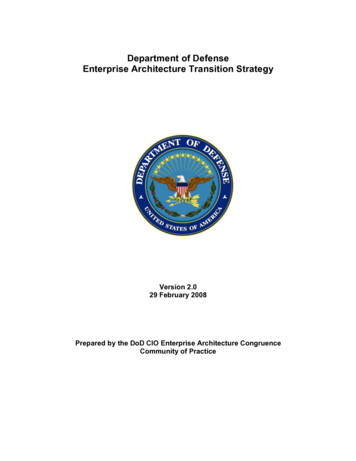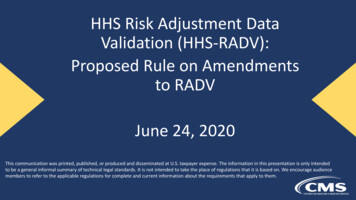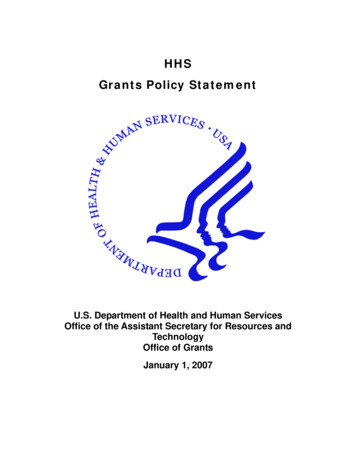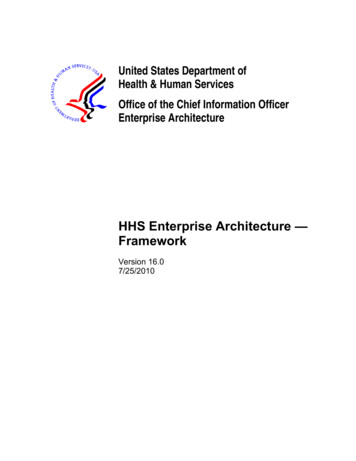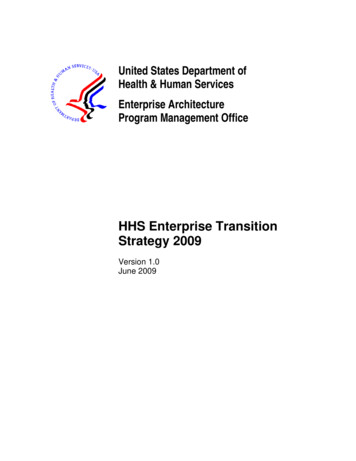
Transcription
United States Department ofHealth & Human ServicesEnterprise ArchitectureProgram Management OfficeHHS Enterprise TransitionStrategy 2009Version 1.0June 2009
ApprovalsThe Health and Human Services(HHS) Transition Strategydescribesgapsidentified betweencurrentandfuture statesof the orgarrizatron,and plans and activities proposed or initiated by the Department and itsOperatingDivisions to fill those gaps.The Transition Strategyalso provides HHS strategiesand interimmilestonesfor implementingplannedmeasuresto achieveprogresstowards its target vision.Approvedby:Mary ForbesLeadArchitect,OfficeofArchitectureHHS Office of the Chief Information OfficerMichaelW. antSecretaryfor InformationTechnologyl io6/oftsaTo"",
HHS Enterprise Transition Strategy 2009Version 1.0Table of Contents1Introduction51.1 Document Structure . 51.2 Purpose . 61.3 Overview of this Document. 61.4 Audience . 71.5 Transition Planning Approach. 81.6 Methodology . 112Transition Planning Drivers132.1 HHS Strategic Goals and Objectives . 132.2 HHS Strategic Planning Initiatives . 152.3 Major External Drivers . 162.4 HHS Enterprise Architecture Principles . 173Major HHS Initiatives183.1 Transition Priorities. 183.1.1Recovery Act . 193.1.2Information Resources Management Priorities . 223.1.3Performance Measurement and Management . 233.1.4OCIO Business Intelligence and Reporting . 243.1.5IT Infrastructure . 243.1.6Security . 283.1.7HHS Identity. 303.1.8Enterprise Data Management . 313.1.9Enterprise Performance Life Cycle . 323.1.10 Health Information Technology . 333.2 Cross-agency Initiatives. 343.2.1Federal Transition Framework . 343.2.2Health Information Technology . 373.3 Completed Segments . 383.3.1Information Sharing Environment (ISE). 383.3.2Information Technology Infrastructure (ITI) . 443.3.3Information Security . 59US Department of Health and Human ServicesOCIO—Office of Enterprise ArchitectureJune 2009i
HHS Enterprise Transition Strategy 2009Version 1.03.3.4Patient Care. 703.3.5Financial Management . 753.3.6Travel . 763.4 In-Progress Segments . 773.4.1Capital Planning and Investment Control (CPIC) . 773.4.2Customer Service . 783.4.3Enterprise Architecture . 783.4.4Food and Drug Supply Monitoring . 793.4.5Grants Management . 793.4.6Records Management. 803.4.7Supply Chain Management . 803.5 Planned Segments . 803.6 IT Investment Alignment to Segments . 803.7 IT Investment Milestones . 80Appendix A HHS Segments82Appendix B HHS Investment Alignment to Segments85Appendix C HHS Segment Alignment to the Federal Transition Framework102Appendix D Acronyms and Abbreviations106Appendix E References108US Department of Health and Human ServicesOCIO—Office of Enterprise ArchitectureJune 2009ii
HHS Enterprise Transition Strategy 2009Version 1.0List of ExhibitsFigure 1: Performance Improvement Lifecycle . 8Figure 2: HHS Business Areas . 9Figure 3: Alignment Between HHS Strategic Areas and HHS Business Areas .10Figure 4: HHS TIC Transformation .26Figure 5: Secure One HHS Organization .63Table 1: HHS Strategic Goals and Objectives .13Table 2: HHS IRM Strategic Goals and Objectives .14Table 3: External Transition Planning Drivers .16Table 4: Transition Planning for HHS Initiatives .18Table 5: IRM Key Projects and Investments .22Table 6: Transition Planning for FTF Initiatives .34Table 7: HHS ISE Segment Findings Summary.40Table 8: HHS ISE Segment Recommendations Summary .41Table 9: HHS ISE Segment Sequencing Recommendations .43Table 10: HHS ITI Transition/Sequencing Schedule .55Table 11: Information Security Segment Recommendations Summary .61Table 12: Information Security Transition Milestones.65Table 13: Patient Care Transition Milestones .74Table 14: Financial Management Transition Milestones .75Table 15: Travel Transition Milestones .76Table 16: HHS Segments (with type and current status) .82Table 17: HHS Investments Aligned to Segments (with Business Area) .85Table 18: HHS Segments Aligned to FTF Initiatives.102Table 19: Acronyms and Abbreviations.106Table 20: References .108US Department of Health and Human ServicesOCIO—Office of Enterprise ArchitectureJune 2009iii
HHS Enterprise Transition Strategy 2009Version 1.0Document Change HistoryVersion ReleaseNumber DateSummary of Changesn/a2/28/2008Previous Transition Plans were produced in 2005, 2006, 2007 and 20080.53/15/2009Transition contents revised to reflect EAAF v3.0 requirements0.95/29/2009Re-structuring of document based on OMB format and content guidance andinclusion of Recovery Act related initiatives1.06/9/2009Segment sections updated to reflect updated EASR informationUS Department of Health and Human ServicesOCIO—Office of Enterprise ArchitectureJune 20094
HHS Enterprise Transition Strategy 2009Version 1.01 IntroductionThe Department of Health and Human Services (HHS) Office of Enterprise Architecturemanages an Enterprise Architecture (EA) Program, under the leadership of the HHS ChiefEnterprise Architect (CEA). The Office of Enterprise Architecture within the Office of the ChiefInformation Officer (OCIO) oversees many of the Department’s core strategic planning andaccountability functions, including capital planning and investment control, informationresources strategic planning, and of course, enterprise architecture. The HHS EA Program fulfillsmultiple Federal mandates related to planning and managing information technology (IT)investments and supporting organizational effectiveness at the Department, Staff Division(STAFFDIV), and Operating Division (OPDIV) levels, and with relevant government-wideinitiatives.Key legislative and management drivers for the HHS EA Program include the InformationTechnology Management Reform Act of 1996 (Clinger-Cohen), the E-Government Act of 2002,the Health Insurance Portability and Accountability Act of 1996 (HIPAA), the GovernmentPerformance Results Act of 1993 (GPRA), and guidance from the Office of Management andBudget (OMB) including Circulars A-11, A-127, and A-130. In addition, the HHS EA Programensures the Department’s compliance with OMB’s Federal Enterprise Architecture (FEA) andFederal Transition Framework (FTF), and responds to regular EA maturity assessmentsperformed by the Government Accountability Office (GAO) and OMB.1.1 Document StructureThis Transition Strategy is organized using the following structure:Part 1 Introduction (this section) provides a general description of the purpose, scope andobjectives, audience, approach, and methodology for the HHS Enterprise Transition Strategy.Part 2 Transition Planning Drivers references strategic goals and objectives, internal andexternal mandates, Departmental commitments and obligations, and other drivers influencing thedeclaration, prioritization, sequencing, and execution of HHS initiatives.Part 3 Major HHS Initiatives summarizes the major current or planned initiatives for HHS in2009, especially those in support of goals and objectives articulated in the HHS Strategic Planand HHS IRM Strategic Plan. This section addresses segments in-progress or completed duringthe previous planning year, and also identifies segments planned but not yet initiated. Whereappropriate, planning milestones and other relevant information is included from the FY2010prospective IT investment portfolio.Appendix A HHS Segments lists the 72 segments identified by HHS and submitted to OMB in2008, with the current status of each segment.Appendix B HHS IT Investment Alignment summarizes HHS major and tactical ITinvestments included in the FY2010 IT investment portfolio, showing the primary alignment ofeach investment to HHS segments.US Department of Health and Human ServicesOCIO—Office of Enterprise ArchitectureJune 20095
HHS Enterprise Transition Strategy 2009Version 1.0Appendix C HHS Alignment to the FTF summarizes HHS IT investment alignment to each ofthe 42 Federal Transition Framework initiatives that are either declared mandatory or otherwisedeemed relevant for HHS.Appendix D provides a listing and descriptions of acronyms and abbreviations using in thedocument.Appendix E provides a listing of references used in the preparation of this document.1.2 PurposeThe HHS Enterprise Transition Strategy is an annual checkpoint on the status and performanceof activities and initiatives currently in progress that move the Department closer to its strategicvision. HHS produces and maintains a five-year Strategic Plan, in which HHS describes a longterm vision for the Department, establishes enterprise goals and objectives, and highlights areasof emphasis and proposes initiatives on which HHS will focus during the strategic planningtimeline. The current HHS Strategic Plan covers the period from 2007 to 2012. The HHS Officeof the Chief Information Officer is responsible for a similar five-year strategic plan focused oninformation resources management. The most recent version of the HHS IRM Strategic Plan alsocovers the 2007-2012 planning horizon. Both strategic plans are updated every three years. TheEnterprise Transition Strategy incorporates progress measures for initiatives from both strategicplans.The Enterprise Transition Strategy provides an annual status of accomplishments made in theprevious year and anticipated progress to be made in the coming year. It reflects plannedbudgetary commitments as captured in the HHS IT portfolio and addresses mandated activitiesregardless of their actual funding status. In this way the Enterprise Transition Strategy can helpHHS draw attention to obligations, strategic gaps, and other risk areas, and providerecommendations for mitigating any such risks. The Enterprise Transition Strategy is also animportant tool to support accurate alignment of IT investments to business strategies andprograms. This alignment helps HHS improve its programs’ performance as measured in the pastby the Office of Management and Budget’s Program Assessment and Rating Tool (PART), andin the future by the new Performance Improvement and Analysis Framework proposed by OMB.1.3 Overview of this DocumentThis document, the HHS Enterprise Transition Strategy 2009, describes the strategy andsequencing to evolve from HHS’ current baseline, representing fiscal year 2009, to achieve thestrategic vision articulated in the current HHS Information Resources Management StrategicPlan 2007-2012 and HHS Strategic Plan 2007-2012. The Enterprise Transition Strategy has ashorter-term perspective than the strategic plans, generally covering a three-year span comprisingthe current fiscal year, the subsequent fiscal year (for which the proposed IT investment portfoliohas already been approved), and the following fiscal year that is the focus of the current budgetplanning cycle. For the 2009 Transition Strategy, the planning horizon covers fiscal years 2009,2010, and 2011, and includes priorities and initiatives proposed under the American Recoveryand Reinvestment Act of 2009. The transition from the baseline architecture to a targetarchitecture consistent with the Department’s vision is an iterative process.US Department of Health and Human ServicesOCIO—Office of Enterprise ArchitectureJune 20096
HHS Enterprise Transition Strategy 2009Version 1.0The Transition Strategy focuses on transitional activities and performance milestones forinitiatives that, when fully implemented, will become part of the target architecture for HHS.Initiatives and projects that have already achieved implementation – including investments inoperations and maintenance or “steady-state” phases – are already part of the target architectureand are therefore not emphasized in the Enterprise Transition Strategy.The HHS Enterprise Transition Strategy 2009 describes the major strategic and tactical driversinfluencing the investments, initiatives, and activities on which HHS will focus in 2009-2011.Transition drivers include internal policies, plans, and initiatives as well as external mandatessuch as legislation, inter-agency agreements, and government-wide initiatives. The scope of thisdocument includes significant HHS initiatives and programs, and plans and activities undertakento align to or comply with cross-agency or other federal initiatives in which HHS participates.Related documents that provide additional details of the HHS Enterprise Transition Strategy andthe enterprise architecture’s role in enterprise transition include: The HHS Strategic Plan 2007-2012The HHS Information Resources Management Strategic Plan 2007-2012The HHS Performance Management PlanThe HHS EA Governance PlanThe HHS EA Program Management PlanThe HHS EA Program Communications PlanThe HHS EA FrameworkThis plan complements related HHS policies and guidance, including: HHS OCIO Policy for IT Capital Planning and Investment ControlHHS OCIO CPIC ProceduresHHS OCIO IT Policy for Enterprise ArchitectureHHS Enterprise Performance Life CycleHHS Information Security Program Policy1.4 AudienceThe intended audience for the Transition Strategy includes all HHS EA stakeholders, as well asthose interested in the operational activities of the HHS EA Program. These stakeholders include: HHS Assistant Secretary for Resources and Technology (ASRT) HHS Chief Information Officer (OCIO) HHS Deputy CIO and Director of the Office of Enterprise Architecture (OEA) HHS Performance Improvement Officer HHS Information Technology Investment Review Board (ITIRB)US Department of Health and Human ServicesOCIO—Office of Enterprise ArchitectureJune 20097
HHS Enterprise Transition Strategy 2009Version 1.0 HHS CIO Council HHS Enterprise Architecture Review Board (EARB) Program Staff and Contractors supporting the HHS Office of Enterprise Architecture HHS OPDIVs and staff involved Enterprise Architecture activities HHS OPDIV investment, business, and technical review boards HHS and OPDIV Capital Planning and Investment Control (CPIC) programs and staff HHS and OPDIV IT Program and Project Managers and staff, including contractors Business Owners of programs, investments, and business functional areas and processes OMB Line of Business programs and staff, including Federal Health Architecture (FHA),Human Resources LOB, Financial Management LOB, Grants Management LOB,Information Systems Security LOB, and IT Infrastructure Optimization LOB Federal Health Information Technology programs and staff, including the Office of theNational Coordinator for Health IT Programs and staff of e-Government and Federal Transition Framework initiatives inwhich HHS participates or the products of which HHS is obligated to incorporate in itsown planning and operations.1.5 Transition Planning ApproachThe enterprise architecture is a strategic resource that helps HHS plan, invest in, and implementinformation technology solutions to meet business needs and help manage the IT investmentportfolio. It provides a mechanism for understanding and managing complexity and change. EAproducts identify the alignment of organizational business and management processes, data flows,and technology. They also enable identification of capability gaps and duplication. The role of theenterprise architecture within the broader cycle of strategic planning and execution is reflected inthe initial “Architect” phase of the iterative performance improvement lifecycle described by OMB,as depicted in Figure 1 (Source: FEA Practice Guidance, December 2006).Figure 1: Performance Improvement LifecycleHHS is a large and diverse organization, with a broad mission and corresponding functionalresponsibilities at both the Department level and, especially, among the Operating Divisions. Inorder to identify mission-specific information resources management goals and objectives, theUS Department of Health and Human ServicesOCIO—Office of Enterprise ArchitectureJune 20098
HHS Enterprise Transition Strategy 2009Version 1.0IRM strategic planning process is structured around the nine business areas defined by the HHSOffice of Enterprise Architecture:Figure 2: HHS Business AreasMission Business Areas Access to CareNon-Mission Business Areas Information Resources Management Health Care Administration Management of Government Resources Health Care Delivery Planning and AccountabilityUS Department of Health and Human ServicesOCIO—Office of Enterprise ArchitectureJune 20099
HHS Enterprise Transition Strategy 2009 Health Care Research and PractitionerEducation Human Services Population Health Management andConsumer SafetyVersion 1.0These business areas are used by HHS to help identify and coordinate work on common orshared business functions within and across the Department, Operating Divisions, and StaffDivisions, to group HHS IT investments, and to help apply appropriate stakeholders, subjectmatter experts, and other resources to strategic and transition planning activities. Since thepublication of the most recent HHS Strategic Plan, these business areas also are used to facilitateprogram-to-investment alignment, as the business areas correspond closely to the strategic areasdefined in the HHS Strategic Plan, as shown in Figure 3, below.Figure 3: Alignment Between HHS Strategic Areas and HHS Business AreasEach of the nine business areas is further decomposed into segments. Segments are discrete setsof business functions grouped according to similarities in mission, goals, objectives, andcommonality of services and business processes. By focusing IRM strategic planning activitieson segment-based perspectives, HHS is able both to capture and reflect mission-specificpriorities and to identify commonalities across segments and across the business areas in whichthe segments reside. This perspective helps ensure that strategic and tactical initiatives areplanned and sequenced appropriately to focus appropriate efforts and resources on the areas ofgreatest impact for the enterprise. Individual initiative programs and investments maintain theirown transition plans as part of program and project management, including establishingperformance measures and milestones. In addition, HHS maintains Segment Transition Plans foreach of the segments under development or for analysis after development. The HHS EnterpriseTransition Strategy reflects a broader perspective covering all major initiatives, cross-segmentpriorities, and major milestones and commitments from cross-agency and government-wideinitiatives. Beginning in 2008, HHS and other federal agencies subject to the OMB EnterpriseUS Department of Health and Human ServicesOCIO—Office of Enterprise ArchitectureJune 200910
HHS Enterprise Transition Strategy 2009Version 1.0Architecture Assessment Framework produced an authoritative list of architecture segments. Thelist of HHS segments appears at Appendix A.1.6 MethodologyThe HHS Enterprise Transition Strategy is produced and updated as a component of the annualstrategic planning cycle. Beginning in 2006, the information resources management strategicplanning process was modified to adopt a segment-based planning approach as a complement toenterprise-wide planning. The HHS Office of Enterprise Architecture convenes and facilitates aseries of strategic and transition planning workshops with business and IT representation from allHHS Operating Divisions and many Staff Divisions. The scope of activities for each workshopincludes a review of existing strategic goals and objectives from both the HHS Strategic Plan(i.e., the business strategy) and the HHS IRM Strategic Plan, a summary of current activities andIT investments, and a discussion of progress on initiatives against performance outcomes.Both business-focused and IRM strategic planning follow a similar process for the developmentand update of the HHS strategic plans. At the broadest strategic level, planning processparticipants identify long-term goals, organized according to mission-oriented delineations ofmajor activities across the Department and its Operating Divisions (OPDIVs). The goalsarticulate what the Department wants to achieve. A set of primary objectives is specified for eachgoal, to describe with more granularity what the Department will accomplish in pursuit of itsgoals. The planning process then focuses on the identification of discrete outcomescorresponding to different goals and objectives that, if realized, would demonstrate successfulachievement of the goals and objectives. This hierarchy of goals, objectives, and outcomesprovides the structure for the HHS Strategic Plan and the HHS IRM Strategic Plan.The annual review of HHS strategic planning documentation and the update of the EnterpriseTransition Strategy identifies current and existing initiatives and investments approved forinclusion in the IT portfolio for the current planning year. This process also identifies additionalobjectives and outcomes that may not have been incorporated in the strategic plans. Participantsanalyze the existing initiative and investment information against the collective set of objectivesand intended outcomes, to identify any gaps between the baseline and target that are notadequately addressed by existing plans. This gap analysis, performed for each of the nine HHSBusiness Areas, helps identify new or emerging themes in terms of required or desiredcapabilities that information resources can deliver. The existence of gaps in existing plans canalso influence revision or re-prioritization of initiatives and planned investments, to encouragethe most effective use of IRM resources.Performance measures provide another important input to transition planning. All current orproposed IT investments specify performance measurement indicators used to evaluate thesuccess of the initiatives funded by the investment and, in most cases, to measure interimprogress of the initiatives during their life cycles. HHS has developed a performancemanagement framework – applicable across all of the business areas – that provides guidance toinvestment owners as to appropriate types of measures that should be specified for theirinitiatives or projects. Using a common performance management framework across all ITinvestments helps HHS implement consistent performance-based evaluation of initiatives, andUS Department of Health and Human ServicesOCIO—Office of Enterprise ArchitectureJune 200911
HHS Enterprise Transition Strategy 2009Version 1.0use the results of that evaluation to help determine transition strategy and adjust sequencingplans as necessary.The HHS approach to performance management recognizes the difference inherent in relevantperformance measures and milestones depending on the status and relative maturity of aprogram, project, or investment. Initiatives and activities identified in the Enterprise TransitionStrategy have, for the most part, not yet achieved full implementation, completion or operationalcapability, so the milestones used to track the performance of these initiatives and activities aremeasures of implementation. 1 Once full implementation and operational capability is achieved,HHS emphasizes the use of operational or outcome-driven performance measures andmilestones, which are the focus of the HHS Performance Management Plan.The Enterprise Transition Strategy addresses strategic planning drivers both internal and externalto HHS, and several different types of initiatives and activities: Current and proposed investments up to and including the fiscal year 2010 IT portfolio;Segments prioritized and initiated for architectural development;Program-based initiatives, spanning multiple investments and projects;Strategic themes and potential new initiatives from the strategic planning process;Health IT initiatives in which HHS is a partner, member, or participant;Cross-agency federal initiativ
Enterprise Architecture Program Management Office HHS Enterprise Transition Strategy 2009 June 2009 Version 1.0 . Title: HHS Enterprise Transition Strategy 2009 Author: Stephen Gantz Created Date:
